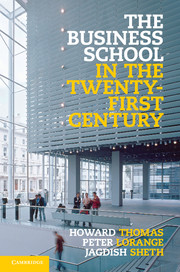Book contents
- Frontmatter
- Contents
- List of figures
- List of tables
- Preface: Tipping or tripping? The business school and its dilemmas
- Acknowledgements
- 1 The business school: history, evolution and the search for legitimacy
- 2 Business school identity and legitimacy: its relationship to the modern university and society
- 3 Rethinking management education and its models: a critical examination of management and management education
- 4 A framework for re-evaluating paradigms of management education
- 5 Evaluating new and innovative models of management education
- 6 Is the business school a professional service firm? Lessons learned
- 7 Enhancing dynamic capabilities in the business school: improving leadership capabilities in curricula and management
- 8 Afterword: business school futures
- Index
- References
7 - Enhancing dynamic capabilities in the business school: improving leadership capabilities in curricula and management
Published online by Cambridge University Press: 05 July 2013
- Frontmatter
- Contents
- List of figures
- List of tables
- Preface: Tipping or tripping? The business school and its dilemmas
- Acknowledgements
- 1 The business school: history, evolution and the search for legitimacy
- 2 Business school identity and legitimacy: its relationship to the modern university and society
- 3 Rethinking management education and its models: a critical examination of management and management education
- 4 A framework for re-evaluating paradigms of management education
- 5 Evaluating new and innovative models of management education
- 6 Is the business school a professional service firm? Lessons learned
- 7 Enhancing dynamic capabilities in the business school: improving leadership capabilities in curricula and management
- 8 Afterword: business school futures
- Index
- References
Summary
INTRODUCTION
In Chapter 3 we questioned the existence of a ‘theory of managing’ and examined the issue of what necessary capabilities and qualities management educators should develop in their students. We initially focused on Mintzberg’s ten managerial roles, which we clustered into interpersonal, informational and decisional skills.
We then reinterpreted them to suggest that management education should cover:
the intellectual skills of analysis, criticism and synthesis;
the study of the domain of management knowledge (i.e. knowledge skills about the structure and functioning of organisations, including process skills about the interactions and interfaces between the different functions);
the range of Mintzberg’s interpersonal skills, including imagination, vision and leadership capabilities;
the multi-disciplinary nature of the managerial skill set required to develop the broader skills of global and cultural intelligence. (Here managers must learn to be sensitive to ethical and socio-cultural differences and take an holistic view of the enterprise in global networks.)
As Thomas (2007: 13) has pointed out elsewhere, it is quite clear that corporate ‘recruiters increasingly require higher-level candidates who possess complex interactive skills (i.e. the ability to link things together and frame complex problems) involving an enhanced judgemental mindset’. He goes on to indicate that the challenge for business schools is ‘to produce students who have the skills, flexibility and training to compete in the new economy defined by globalization and technological change’. In other words, the curriculum must increasingly embrace a cross-disciplinary, holistic and interactive form of education with a strong focus on global exposure, ethics and social responsibility.
- Type
- Chapter
- Information
- The Business School in the Twenty-First CenturyEmergent Challenges and New Business Models, pp. 240 - 266Publisher: Cambridge University PressPrint publication year: 2013

